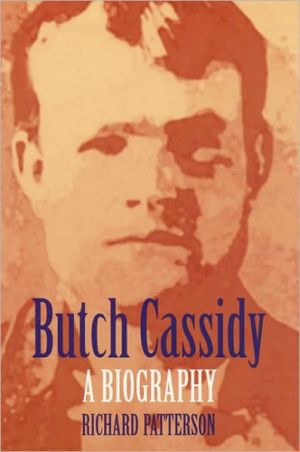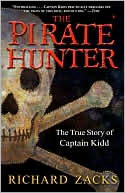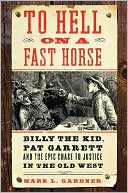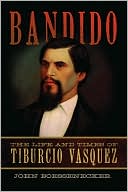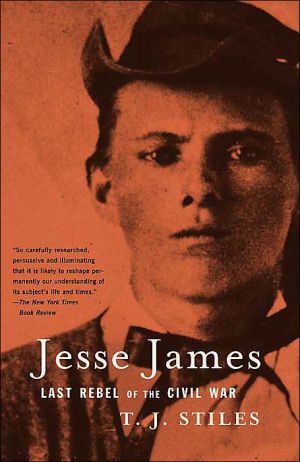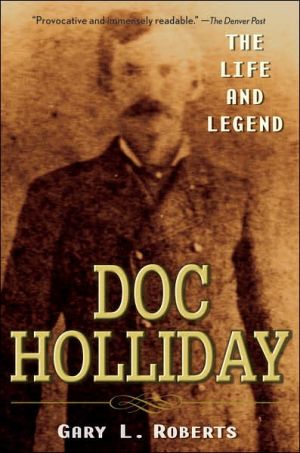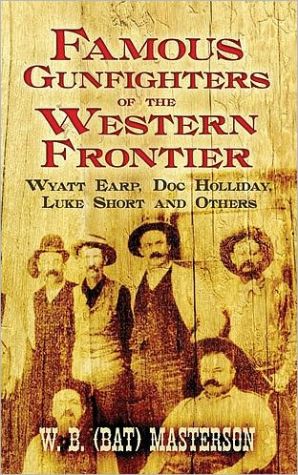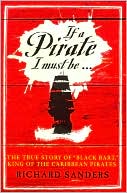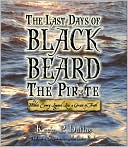Butch Cassidy: A Biography
Separating mythology from actual events in the life of Butch Cassidy has been made extremely difficult by the many stories told about him by family members, acquaintances, and writers after his presumed death in a Bolivian village. In an exhaustive search of reminiscences, newspapers, and books, Richard Patterson has written the definitive biography of the outlaw whose legend is rivaled only by that of Billy the Kid.\ Born to a devout Mormon family in Utah, Robert Leroy Parker demonstrated...
Search in google:
Separating mythology from actual events in the life of Butch Cassidy has been made extremely difficult by the many stories told about him by family members, acquaintances, and writers after his presumed death in a Bolivian village. In an exhaustive search of reminiscences, newspapers, and books, Richard Patterson has written the definitive biography of the outlaw whose legend is rivaled only by that of Billy the Kid. Born to a devout Mormon family in Utah, Robert Leroy Parker demonstrated early on the acquisitiveness and restlessness that would lead him into a criminal life. As a teenager, he was arrested for stealing a saddle. In this same period, he met Mike Cassidy, a cowhand skilled in using a running iron to change livestock brands. Eventually Parker drifted into Telluride, where he met Tom McCarty and Matt Warner. McCarty taught them how to rob banks and trains, laying out for Parker a career path that would lead him to a new name—Butch Cassidy —and eventually force him from the country.Patterson has followed every lead to provide a vivid account of Cassidy’s life and has scrutinized the stories of men who claimed to be Butch. Butch Cassidy brings together diverse anecdotes, providing both a wonderful tool for researchers and a lively read. Publishers Weekly Butch Cassidy had many names. Born into a devout Mormon family in 1866 as Robert Leroy Parker, he became George Cassidy in 1889 and, a few years later, Butch Cassidy. It was under the last name that he served a two-year prison term in Wyoming and, on his release, became one of the leaders of the gang dubbed the Wild Bunch by law enforcement officials and the press. The original crew, consisting of eight or nine outlaws, robbed trains and banks from South Dakota, Idaho and Montana south to Wyoming and Colorado; they also rustled cattle and stole horses. Eventually, Cassidy was wanted in so many states that he fled to South America with fellow holdup man Harry Longabaugh ("The Sundance Kid") and Harry's wife, Etta. They lived in Argentina and then traveled to Chile, Bolivia and Peru, resuming their criminal careers along the way. Butch was presumably killed after a robbery in a 1908 shoot-out; Patterson examines and dismisses most of the conjectures about Cassidy's survival. While there is no denying that Patterson has done an enormous amount of research (there are almost 100 pages of notes), the book has one big flaw: it cries out for maps. Even a standard atlas does not give enough detail to guide the reader through the almost impenetrable jungle of geographical detail here. Patterson, author of the Historical Atlas of the Outlaw West, obviously knows the material, but it may prove too daunting for others.
Chapter One \ CIRCLE VALLEY\ 1879-1884\ It was something nearly every Mormon mother dreaded, yet knew full well that someday she might have to face. For Bob Parker's mother, it was especially difficult--he was her firstborn and he was leaving home. But he was now eighteen, not yet a man in her eyes but surely old enough to be one.\ Bob had not prepared for the trip, that was plain. She could see that he needed something for the trail, a bedroll or something, because the nights could still get cold if he was heading for the high country. She went to the bedroom and returned with the blue woolen blanket. Also, he had not thought about food, so she hurried to the kitchen and found some cheese, some raisins, some fresh bread, and something he really favored: a jar of bullberry preserves.\ Bob watched silently as his mother wrapped the provisions in a cloth and put them in the blanket, making a narrow, tight roll that he could tie behind his saddle. As a final thought, she may have slipped in one of the family's worn, leather-bound copies of The Book of Mormon. It would have been like her to do so, and to ask her son to promise that every day, if he had time, he would try to read a passage or two.\ Outside, Bob's mare, Babe, and his colt, Cornish, waited patiently, perhaps somehow anticipating that this was to be a special day. The family dog, Dash, sniffed and panted, eager to share in whatever was breaking the parker family's early morning routine. Bob knew that Dash would try to follow and that he would have to put him on a rope until he had gone.\ After tying up Dash, there was nothing left to do but leave. Bob swung up and turned Babe toward the road, trailing Cornish behind on a long lead. His mother held Dash's rope and watched as Bob clicked Babe to a trot, kicking up dust as he skirted the four young Lombardy poplars that he and his mother had planted one day when his father was off working at Silver Reef or Frisco or somewhere. It was a tradition--Mormons planted Lombardy poplars wherever they settled. It made Mormon country something special and distinctive. Lombardys were kind of like her son--they grew boldly and fast without much tending.\ Dash lunged, straining at the rope, but she held it tightly, watching her son grow smaller in the distance. He turned once more and waved, and then he was gone.\ \ \ According to Utah rancher Patrick Ryan, who first hired Robert LeRoy Parker in 1879 as a hand when the boy was only thirteen, the husky lad could already do a man's work around a ranch. Although Ryan thought young Bob was a little impatient with the horses, he was otherwise quiet and inoffensive. He found the boy smart and dependable, but most of all, Bob's family desperately needed the money he could earn at Ryan's. Ryan and Bob got along well, and the rancher regretted to see him leave a little over two years later when Bob found work with ranchers closer to his home.\ Bob's parents, Maximillian and Ann Gillies Parker, had moved their brood of then six children from Beaver, Utah, to near Circleville the year Bob turned thirteen. At the time, the town of Circleville was hardly more than a few stores and a schoolhouse, snugly nestled near the confluence of Cottonwood Creek and the Sevier River in what is now southern Piute County. The Parker property, 160 acres, which Maximillian bought from a homesteader named James, lay three miles south of town at the mouth of Circleville Canyon, at the southern edge of Circle Valley, which was then a dale of hardworking Mormons struggling to make a living from crops and cattle on parched Utah land badly in need of irrigation.\ The elder Parker had been born in Lancashire, England, where Bob's grandfather was a weaver in a textile mill. When Maximillian was nine, missionaries converted the family to the Church of Jesus Christ of Latter-Day Saints during a Mormon sweep through England and Europe in a search of artisans and craftsmen who would agree to come to America and enrich the Valley of the Great Salt Lake. In 1856, when Maximillian was twelve, his parents agreed to take on the American adventure. After a perilous trek across the plains with one of the first Mormon handcart companies, the Parkers eventually settled in Beaver, Utah, where Maximillian's father was called to work in the local woolen mill.\ Ann Gillies's family, who were Scottish, were also converted to the Mormon church in England and, like the Parkers, came to Utah with one of the handcart companies. Maximillian and Ann met sometime in the early 1860s and were married in 1865. Robert LeRoy, their first child, was born on April 13 the following year.\ During their early years of marriage, Maximillian carried the mail on horseback from Beaver south to Panguitch along the Sevier River. During those runs, his route took him through Circle Valley. It was rough country and still only sparsely settled, but the few homesteaders there were friendly and honest people. Someday, Maximillian thought, it might be a good place to raise a family. For Maximillian, that day came in the spring of 1879, when he and Ann packed up the children and what little they had accumulated in fourteen years of marriage and headed south.\ The Parkers squeezed the children into a two-room log cabin the former owner had built at the base of a small hill. That first year Max, as he soon was to be called by his neighbors, cleared enough brush away to plant a crop of summer wheat. But soon after the planting, ruthless winds destroyed his efforts. Max planted a second crop, and it, too, was blown away by the dry gusts that often roared in from the west over the northern edge of the aptly named Hurricane Cliffs. When Max's second planting was destroyed, only a few days were left before the summer sun would end any chance of a growing season, but this time the winds eased off and the seeds took root.\ With the wheat in the ground, Max went off to look for work and left Ann and the children to attend to the Circle Valley ranch. Most of his jobs consisted of temporary employment with mining companies. The 1880s were an erratic period of Utah mining--promising strikes, overnight boom towns, but then precipitous busts. One of Max's first jobs was cutting and hauling wood at the Silver Reef Mine in the Pine Valley Mountains northeast of St. George. The mine was nearly 100 miles from Circle Valley, which permitted Max only an occasional Sunday at home. Also, Silver Reef, a non-Mormon town created by the mining company, was tough and violent, and soon became famous for drunken brawls and killings. But for the most part, the Mormons who came there to work were treated with respect by the gentiles, and the pay was better than average.\ When the Silver Reef job played out, Max found similar work in the San Francisco mountains at Frisco, a silver camp sixteen miles west of Milford. New York financier Jay Cooke was building a leg of the Utah Southern Railroad at Frisco to reach a mine at Squaw Springs, which he had recently added to his investments. At Frisco, Max was again a long way from home, but he was not far from Hay Springs where Bob was helping out at Pat Ryan's ranch. For a while Max also worked in Pioche, Nevada, where he hauled wood for charcoal burners.\ With Max's income, plus the pay Bob brought home from Ryan's, that fall the Parkers were able to buy a few cattle. But then came the winter of 1879, one of the worst to strike southern Utah in a decade, and all but two head of the Parker herd were wiped out.\ The loss of the cattle set the family back, and their luck was slow to improve. Also, there were more mouths to feed: the Parkers now had seven children, four boys and three girls, and there would be more--in all fourteen. Large families were common among the Mormon families, especially in southern Utah. Not only were they important to rural families in drawing a livelihood from the land, church doctrine proclaimed that it was virtuous to bring waiting souls into the world and that a woman's highest glory was to give birth to many children. Furthermore, it was taught that a man's family went with him to the Hereafter, and that his glory in Heaven would be dependent in part on the progeny that he could gather about him there.\ In an effort to make ends meet, Max attempted to homestead a second parcel of land, but his claim was challenged by another settler. The dispute ended up in the hands of the local Mormon bishop who, in the absence of the civil law and in accordance with church custom, mediated the matter. The outcome was not favorable to the Parkers. While Ann Parker was a devout member of the Latter-Day Saints and attempted to raise the children according to Mormon precepts, her husband had wavered at times. Moreover, he had a poor attendance record at services. Also, long before then Max Parker had taken up smoking, which was against Mormon teachings and seriously frowned upon by the local congregation. When the bishop decided against him on the homestead claim, Max was furious, convinced that the bishop had punished him for his slackened attitude toward the teachings of the Saints instead of judging the dispute on its merits.\ The bishop may have been prejudiced against Max, but it may not have been for the reasons Max believed. In the bishop's opinion, Max may have been becoming too acquisitive. Max already owned 160 acres, which was not a small parcel of land for a Circle Valley family at the time. By Mormon tradition, farming in the early 1880s was still small scale. The bishop may have only been following the dictates of Brigham Young, who had insisted that no man should own more land than he could personally cultivate.\ The Parker family struggled on and things got a little better. Ann found work with a neighboring rancher, Jim Marshall, operating his small dairy, and Marshall also offered to take on young Bob as a hand, which worked out better for the boy. The Marshall ranch, located in what is now the northern edge of the Dixie National Forest, was much closer to the Parker home than Pat Ryan's ranch, which was almost a day's ride from Circle Valley. Working at Marshall's meant young Bob could live at home.\ Ann Parker probably was eager to have young Bob back within the fold. While working for rancher Patrick Ryan, the boy had run into trouble with the law. One day Bob rode into town to buy a pair of badly needed overalls. Finding the general store closed, he was no doubt irritated. He had taken time oft from work and it appeared that he had made the long, dusty ride for nothing. So when he found a way to gain entry to the building, he thoughtlessly let himself in. He searched the shelves and located the pair of overalls he wanted and hastily scratched out a note to the store owner, leaving his name and promising that he would return later and pay up. But when the owner opened the store the following morning and found the note, Bob's ad hoc arrangement did not set well with him and he complained to the town marshal. The matter was eventually settled, but not without embarrassment to Bob and his family.\ Then there was another incident. According to Parley P. Christensen, who served thirty years as sheriff of Juab County, Utah, Bob was also arrested for stealing a saddle. The arrest supposedly occurred in what is now Garfield County, probably sometime between 1879 and 1884. No record of the charges made in this matter have been found, but Christensen claimed that while in custody, Bob had been mistreated by the authorities.\ Those who put emphasis on such things might suggest that the trousers incident, the mistreatment by the Garfield authorities, and the impact on the family of the Mormon bishop's biased decision in the dispute over Max Parker's homestead claim all left a strong impression on young Bob that justice was not always rendered fairly, and that perhaps these occurrences may have been largely responsible for Bob's decision in later years to formulate his own rules as to what was right and wrong.\ Despite young Bob Parker's difficulties with the law, he was not an unruly youngster at home--although he would have been considered headstrong for a Mormon youth, as perhaps were his brothers. While Ann tried to raise the children in the church, according to Lula Parker Betenson, Bob's sister, most of her brothers followed their father's example and side-stepped its strict covenants when possible. Even before moving to Circleville, while living in Beaver, Bob would find endless excuses not to go to services, and eventually his mother gave up trying to force him to go.\ At the ranch in Circle Valley, however, the Parkers did observe the traditional Mormon family weekly "home evenings," the purpose of which was to bind the family together by promoting religion, education, and recreation in informal gatherings. The typical home evening usually began with a prayer, preferably having something to do with the sanctity of the home. The family usually sang hymns next, often followed by recitations or songs by the children. In many homes the father would give a short talk on a topic illustrating a point of faith or morals, or on something emphasizing the importance of children accepting responsibility. This lesson would frequently be followed by games (often charades), and then more singing. The evening would usually end around nine or so with more prayers or hymns. Lula Betenson recalled that Bob willingly participated in these gatherings and joined in the musical parts by playing the harmonica.\ Ann Parker's work running the dairy at the Marshall ranch kept the family in milk, cheese, and butter, and brought in needed extra income, but the early morning eight-mile ride to Marshall's was a problem. After discussing the matter with Jim Marshall, Ann decided that the practical thing to do was to move to the ranch, at least during the summer months, so she could get an early start on her daily duties. Bob was already working for Marshall as a hand, and Marshall agreed to hire two of Bob's younger brothers to help their mother with the dairy, and let all four Parkers live in a small house on the property. As one would expect, Max Parker was not exactly enthusiastic about this idea, but he finally conceded that his daughters could keep house for him and that the extra money was worth whatever inconvenience the arrangement would create. With Max's reluctant approval, Ann and the three boys moved to the Marshall ranch in the summer of either 1881 or 1882.\ Beginning perhaps as early as 1883, Bob Parker again defied the law, but this time it was with the consent of his family.\ A unique aspect of social life in early Mormon Utah was the church-sponsored practice of plural marriage, begun secretly by the Mormons before their migration west. In 1852, polygamy was publicly announced and officially defended by the church leaders as a religious principle. The practice, however, was not widespread, and some Mormon men refused to engage in it because of personal feelings or because they could not afford it. Also, the church wisely required that, before seeking additional wives, a man obtain permission from his first wife. Among church leaders, however, the practice was fairly common.\ Polygamy, however, was against federal law. In 1882, Congress passed the Edmunds Act, which declared the practice a felony punishable by up to five years' imprisonment and/or a $500 fine. Aimed specifically at Utah, then still a territory, the law also disfranchised polygamists and rendered them ineligible for public office and even jury service. Polygamous Mormons adopted various measures to elude federal officers, including constructing ingenious hiding places in their homes and on their lands. In rural southern Utah they frequently escaped into hideouts in nearby canyons or were harbored by friends and neighbors until the marshals moved on. Polygamists' "underground railroads" also were developed throughout the territory, with highly successful communication systems complete with secret codes and warning devices.\ It is believed by some that the Parker family assisted in operating a branch of one of these underground railroads, temporarily concealing fleeing "polygs" and arranging for their eventual escape into Mexico. According to Utah writer Kerry Ross Boren--whose great-grandfather was supposed to have made use of the escape route through Circle Valley--young Bob Parker played an integral part in this operation.\ Ann Parker and her sons had been boarding at the Marshall ranch for about two years when owner Jim Marshall hired a new hand by the name of Mike Cassidy. Although only a few years older than Bob Parker, Cassidy probably had been drifting from ranch to ranch for some time and was an experienced horse wrangler and a skilled livestock handler. He and Bob immediately struck up a friendship, much to the dismay of Bob's mother, who saw in Cassidy a hardened cowboy who had been put on his own too early and no doubt had acquired vices that she did not want to see in her son. Bob, on the other hand, saw in Mike the man he wanted to be--unrestrained and free to drift in any direction.\ As suspicious as she was, even Ann Parker may have underestimated Mike Cassidy. By the time Cassidy signed on at the Marshall ranch he probably was already well-experienced at stealing livestock. Rustling was an ongoing problem in and around Circle Valley, especially the picking off of mavericks (unbranded calves separated from their mothers) which would be whisked away from the herd as soon as they could feed on their own. Worse still, when ranch owner Jim Marshall was not around, Mike Cassidy and his pals were probably bringing strays back to the ranch and rebranding them right there in Marshall's corral--and young Bob was probably helping in the task. But as Bob's sister later commented, their mother accepted the fact that her responsibility ended at the dairy barn, and she could do little about what occurred on other parts of the Marshall ranch. But it was especially difficult for her when Cassidy went so far as to give her son a six-gun and teach him how to use it.\ Ann knew that lecturing Bob would do no good--he was old enough to do what he pleased--but she felt that it might help if she could put some distance between him and Mike Cassidy. In April of 1884 she moved back to the Parker ranch in Circle Valley, in the hope that Bob would follow. But it was not to be. In June, Bob announced that he would be leaving Circle Valley and probably Utah. When Ann asked where he was going, her son said that he was not sure, maybe to Colorado to work in the mines in the mountains above Telluride. His reasons were familiar words to Circle Valley families: "Ma, there's not much here for me. No future. Pay in Utah is low--you know that. Maybe twenty or thirty dollars a month with board--and the board's not much to brag about in most places. There's no excitement around here. I'm not a kid any more. Gotta be thinking about my future."\ When Ann reminded Bob that he was only eighteen, he answered that most of his friends of the same age were on their own and that many of them were already married. When she confided that she worried about him going off alone, he told her that he would not be alone. On hearing this, her first thought might have been that he was riding off with the despised Mike Cassidy, but it was rumored that Cassidy had already left Jim Marshall's ranch. No, it would not be Mike Cassidy; Bob said that his friend, Eli Elder, would be going with him.\ Mike Cassidy had in fact already left the Marshall ranch. More than likely his skill with a wide loop and running iron had become too well known. It was rumored that he had gone south, probably to Mexico.\ On the night Bob announced that he would be leaving Circle Valley, his father was working away from home and was not expected to return until the next evening. It would hurt him deeply that Bob had left without waiting to say good-bye; yet Bob knew that his father would understand his wanting to leave: the feeling of confinement, the need for adventure. In his youth Max Parker had undoubtedly experienced those feelings himself, and had done something about them. When he was no older than Bob, Maximillian Parker had guided Mormon emigration trains from St. Louis through the treacherous Rocky Mountains. When just a few years older than his son, and newly married, he was dodging Ute arrows while carrying the mail along the rugged banks of the Sevier River. And only months after that he was fighting alongside his fellow Mormons in Utah's Black Hawk War, the culmination of an ongoing dispute over the occupation of the Ute's favorite hunting grounds.\ Ann Parker pleaded with her son to postpone leaving for just a day, until his father returned. Although for much of his life Max Parker was away from home for weeks at a time, when he could be with his children he was a loving father. He was never ill-tempered with them, and never laid a hand on them in anger. His children had great respect for him, and when he spoke they listened. But Bob was insistent about going, saying that he should have left already, and that he absolutely had to leave first thing in the morning. Though Ann may have wondered about Bob's hurry, she did not press it, nor did she question her son the next morning why he was "traveling light," without a pack animal or even a camp outfit. But if Ann Parker failed to find it unusual that her son could not wait one more day to tell his father that he was leaving his house, possibly never to return, others did not. There has been much speculation, and some fact bears it out, that Bob Parker had good reason for a quick departure.\ Bob Parker may have planned to work in the mines in Telluride, Colorado, as he told his mother the night before he left, but he may already have been hired to do another job to help deliver a bunch of stolen horses to Telluride for the notorious rustler Cap Brown.\ Cap Brown is believed to have drifted into southeastern Utah sometime in the 1870s, making his headquarters somewhere in the desolate Robbers' Roost area--eastern Utah's high desert country of twisting canyons that lay between the Henry Mountains to the west and the La Sal Mountains to the east. On a map, the Roost area is roughly the shape of a parallelogram: one border stretches southeastward along a line from the town of Hanksville to the place where the Dirty Devil River enters the Colorado River, another border runs northeasterly up the Colorado to the Green River, a third follows the Green for fifty miles or so northwest to the San Rafael River, and the fourth runs southwest across the San Rafael Desert back to Hanksville.\ Brown may not have been the first rustler to operate out of the Roost, but he was one of the most successful. Early on he found it profitable to supply horses to the mining communities of Colorado by raiding herds and capturing strays in southern Utah. At first Brown probably operated alone, but in time he cautiously recruited local wranglers in crews of three or four, mostly young cowboys eager to bolster their meager wages. One cowboy Brown recruited was probably Mike Cassidy and, in time, another was more than likely Bob Parker.\ Bob Parker and Cap Brown probably first met some time around 1882, chances are in the company of Mike Cassidy at the Marshall ranch, where Brown often stayed overnight during forays after horses into Circle Valley and around the northern edge of what is now Dixie National Forest. Alternately, they may have met the following year when Bob was working as a cowhand for Charlie Gibbons of Hanksville, on a ranch Gibbons owned near the Henry Mountains in partnership with a local doctor-turned-cattleman, J. K. W. Bracken.\ According to old-timers who frequented Robbers' Roost, in the spring of 1884, at Mike Cassidy's recommendation, Bob had been hired to pick up around twenty horses from two of Cap's men in Kingston Canyon (about six miles east of Circleville), and, after a brief instruction on trail-breaking a herd of that size, lead them along the Dirty Devil River to near Hanksville, where Brown had a shack in Bull Valley. From there Brown was to guide Bob and the herd eastward across the cedar ridges and parched swales of Roost country, giving them a start toward the San Rafael Desert. Brown would eventually turn back and leave Bob to take the herd alone across the Green River and on to Moab, where Bob would cross the Colorado River at Taylors' ferry, if the river was up, then skirt the La Sal Mountains to the north and finally head southeast down the Dolores and San Miguel river valleys to Telluride.\ Bob Parker may have been in a hurry to leave Circle Valley to avoid being late for his rendezvous with Cap Brown's pals in Kingston Canyon, or there may have been another reason. According to Matt Warner, who later rode with Bob and joined him in robbing the San Miguel Valley Bank at Telluride in 1889, Bob told him that he had fled Circle Valley that day because he himself had stolen some horses from a neighbor, Jim Kittleman.\ A version of this incident that has survived the years, and which probably has enjoyed some elaboration, tells of Bob being pursued by two lawmen, probably deputy marshals, who tracked him down and caught him with Kittleman's missing animals. Bob offered no resistance, but to play it safe the officers handcuffed him before placing him in his saddle for the trip back to Circleville, nearly a full day's ride. Around noon the men decided to stop for a rest and a bite to eat. While one deputy built a fire, the other went to a nearby creek for water for coffee. Seeing his chance, Bob sneaked up on the deputy by the fire and grabbed his gun. Catching the other man by surprise when he returned from the creek, Bob also disarmed him, took his keys, and unlocked the handcuffs. In less than a minute Bob was mounted up and on his way, leading the stolen ponies and the lawmen's horses. But after riding only a short distance Bob noticed that the lawmen's canteens were still tied to their saddles: he had left them without water for the long walk back to town. Bob turned around and rode back, tossed them their canteens, and bid them good-bye once more.\ Whether or not this story is true, Kittleman did lose some horses, apparently finding them missing shortly after Bob had left Circle Valley, and Bob was a suspect. However, Lula Parker Betenson vehemently denied that her brother would have taken them. According to Lula, "Bob would as soon have stolen from his own father as from Jim Kittleman," a close friend. Lula never denied that her brother eventually became an outlaw, but she sternly insisted that he would never have stolen from Kittleman, that one of Bob's "most outstanding virtues was his loyalty to friends and family." Lula acknowledged that Bob had ridden west to Kingston Canyon on leaving Circle Valley that day, but she declared it was not to meet with rustlers. She said that, as he had told his mother, he met his friend, Eli Elder, who was to join him and ride to Telluride to look for work.\ The Kittleman incident was not the only cloud under which Bob left Circle Valley that June. The day after his departure, Max Parker was in Circleville and heard gossip that two local boys, whom thus far history has identified only as Charley and Fred, were suspected of stealing cattle. When confronted, the boys, both friends of Bob, produced a bill of sale bearing the name Robert LeRoy Parker, thus suggesting that Bob had owned the cattle and had sold them to the two suspects. Furious, Max sought out the town constable, James Wiley, for an explanation. Wiley's response only angered Max further: the constable more or less admitted that Bob had probably signed the bill of sale simply to help his friends. Wiley's answer was that Bob could afford to take the blame since he was already leaving Circle Valley, while Charley and Fred, both of whom were married, were not in a position to leave. Also, since the cattle had been found and returned to the owners, Wiley apparently intended to drop any charges against Bob. When Max argued that even if the charges were dropped his son could no longer hold his head up in the community, Wiley reminded him that if he insisted on making trouble the issue probably would end up with the local LDS bishop, and Max's record with the bishop was not too good, so why didn't he just drop the matter. There was no way to find Bob and have him return and defend himself, so Max accepted Wiley's advice.
IllustrationsixPrefacexiAcknowledgmentsxiiiCircle Valley: 1879-18841Telluride: 1884-188912Return to Telluride: 188921Flight: 188932On Upper Wind River: 1889-189043Blue Creek and Afterward: 1890-189250A Five-Dollar Horse: 1892-189459The Big Stone House: 1894-189671Free Again: 189679Montpelier: 189688Castle Gate: 1896-189798LongabaughIIIThe Wild Bunch: 1896-1897123Busy Times: 1897-1898131Alias Jim Lowe: 1898-1900141Tipton and Winnemucca: 1900158Fort Worth and New York: 1900-1901173Wagner:1901187Cholila: 1901-1904192Moving On: 1904-1907204San Vicente: 1908214Horizons227Phillips238Afterthoughts248Notes257Bibliography337Index347
\ CHOICE"[Patterson] deftly separates mythology from actual events, bringing the story of Butch Cassidy up to date with all the most recent discoveries. This lively read is well researched and definitive."—Choice\ \ \ \ \ Utah Historical Quarterly"For those who wish the most complete and readable summary of all that has thus far been written on Butch Cassidy, Richard Patterson's biography of him presently stands as that work"—Utah Historical Quarterly\ \ \ CHOICE"[Patterson] deftly separates mythology from actual events, bringing the story of Butch Cassidy up to date with all the most recent discoveries. This lively read is well researched and definitive."—Choice\ \ \ \ \ \ Utah Historical Quarterly"For those who wish the most complete and readable summary of all that has thus far been written on Butch Cassidy, Richard Patterson's biography of him presently stands as that work"—Utah Historical Quarterly\ \ \ \ \ \ Publishers WeeklyButch Cassidy had many names. Born into a devout Mormon family in 1866 as Robert Leroy Parker, he became George Cassidy in 1889 and, a few years later, Butch Cassidy. It was under the last name that he served a two-year prison term in Wyoming and, on his release, became one of the leaders of the gang dubbed the Wild Bunch by law enforcement officials and the press. The original crew, consisting of eight or nine outlaws, robbed trains and banks from South Dakota, Idaho and Montana south to Wyoming and Colorado; they also rustled cattle and stole horses. Eventually, Cassidy was wanted in so many states that he fled to South America with fellow holdup man Harry Longabaugh ("The Sundance Kid") and Harry's wife, Etta. They lived in Argentina and then traveled to Chile, Bolivia and Peru, resuming their criminal careers along the way. Butch was presumably killed after a robbery in a 1908 shoot-out; Patterson examines and dismisses most of the conjectures about Cassidy's survival. While there is no denying that Patterson has done an enormous amount of research (there are almost 100 pages of notes), the book has one big flaw: it cries out for maps. Even a standard atlas does not give enough detail to guide the reader through the almost impenetrable jungle of geographical detail here. Patterson, author of the Historical Atlas of the Outlaw West, obviously knows the material, but it may prove too daunting for others.\ \ \ \ \ Kirkus ReviewsA thorough search to set the record straight about questions surrounding the fate of a legendary outlaw. Patterso, a retired lawyer turned freelance writer and editor, seems to have followed nearly every trail, well or little known, ever left by Cassidy, the personable, restless drifter, skillful cowboy, and elusive prey of all those unrelenting posses and Pinkerton, railroad, and bank detectives — as well as the US Cavalry — who dogged him across the vast Old West spaces of Colorado, Utah, Wyoming and, later, South America. Patterson defines Robert Leroy Parker (Cassidy's real name), born Mormon in Utah, as a puzzling good/bad guy, a hard-working ranch hand who was always loyal to his employer of the moment, kind to children, and yet also a bold cattle rustler, horse thief, and robber of banks and trains who cleverly planned successful escape routes with his associates from the famous Wild Bunch gang. In time, the West was no longer a safe place for even him to hide: Communications improved, and multiple pursuers closed in. Some Wild Bunch members eventually found themselves caught, imprisoned, or hanged. Cassidy and Harry Longabaugh (the so-called Sundance Kid) then fled to South America, where they died in a payroll robbery — or did they? Patterson's search for the facts was complicated by conflicting and confusing reports that compel speculation to this day. Persuasive accounts of later Cassidy sightings and meetings, for example, can only further complicate matters.\ \
